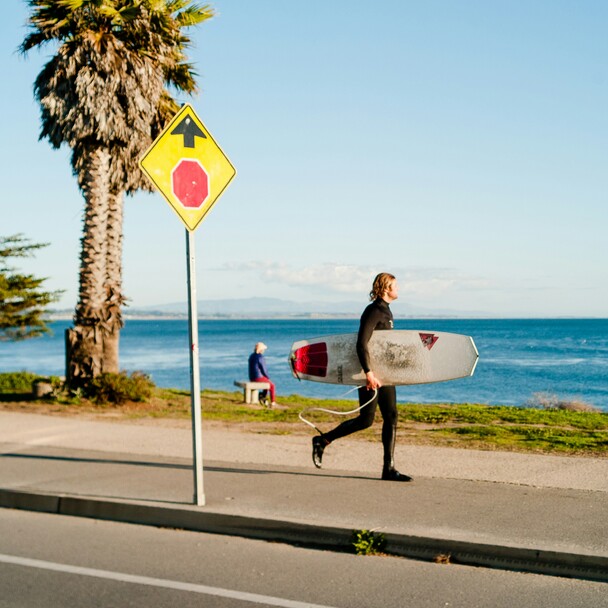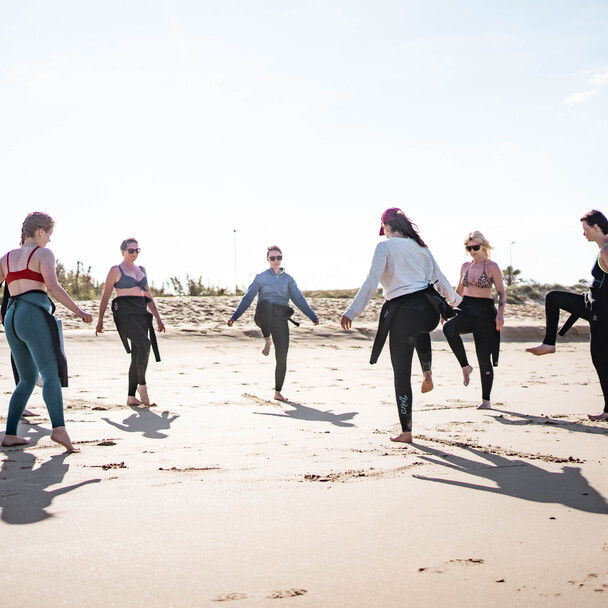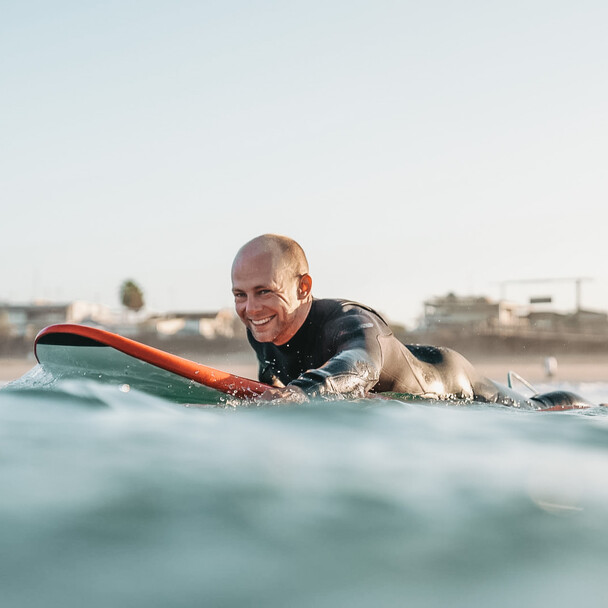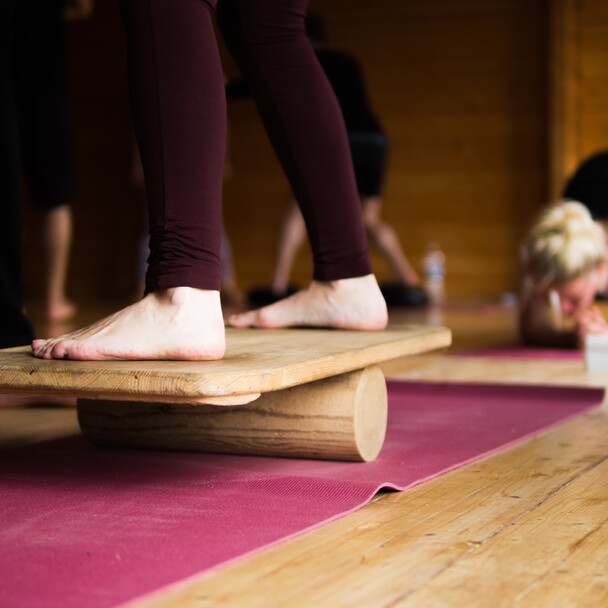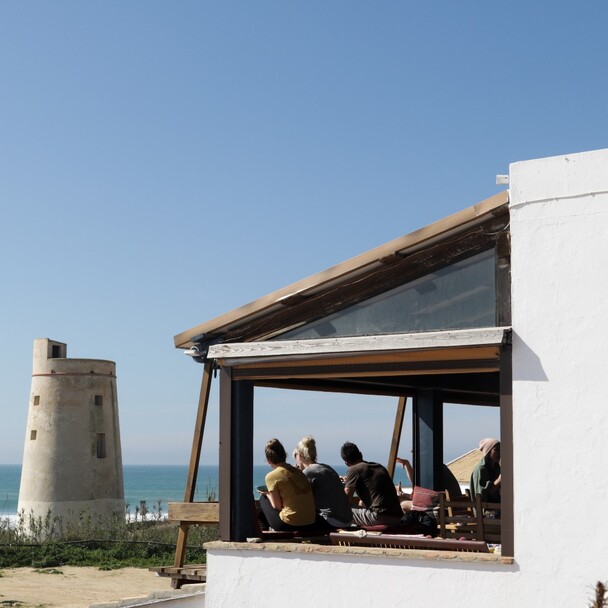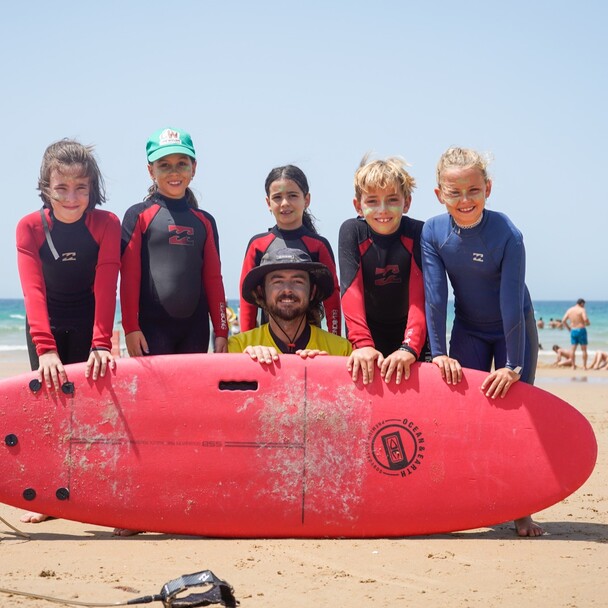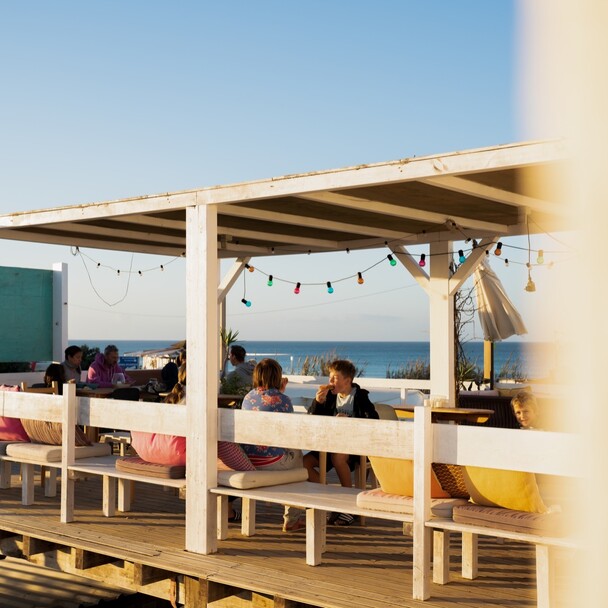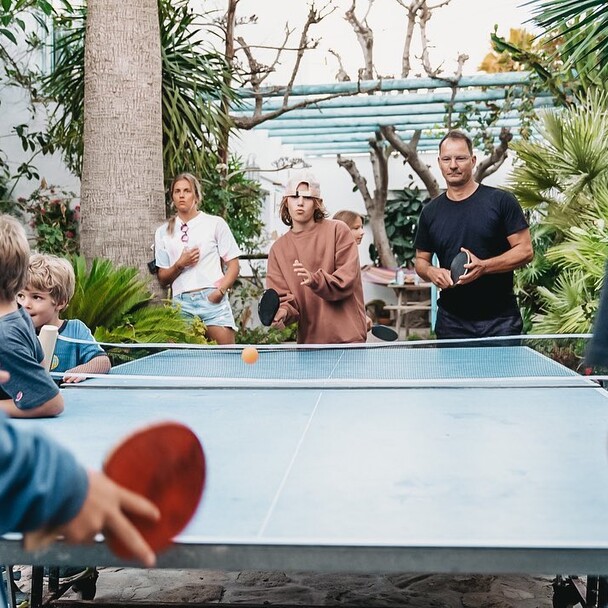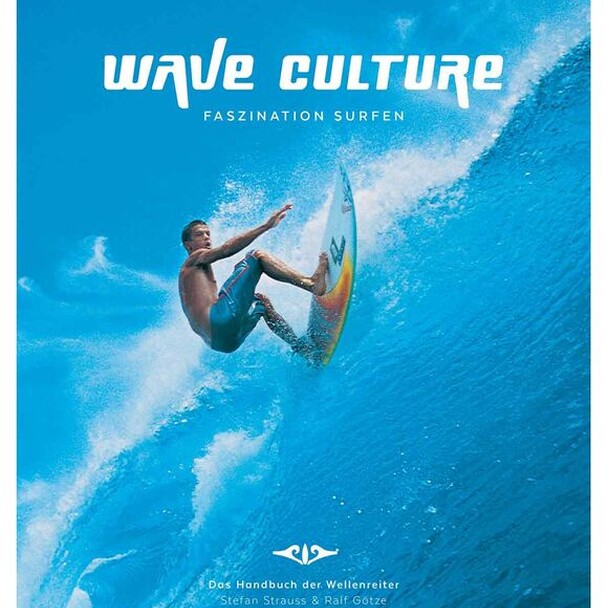Learn to surf: The ultimate guide for beginners - tips, tricks and the best spots
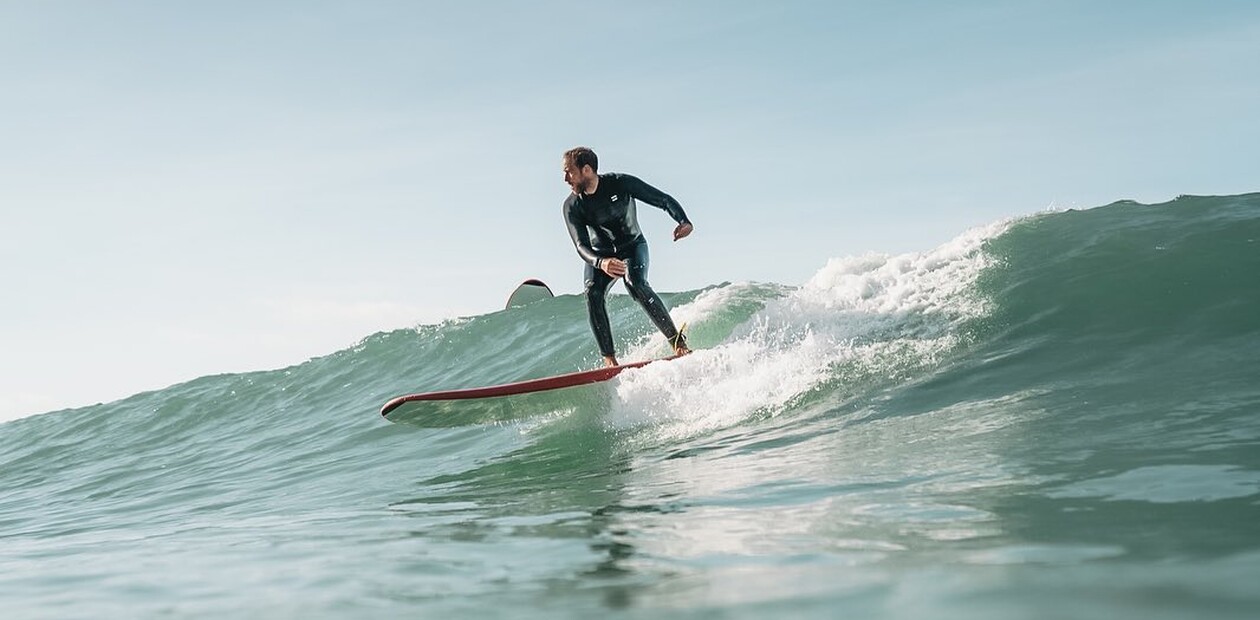
- Introduction
- The basics of surfing
- Definition & History
- Equipment for learning to surf
- Surfboards, wetsuits & accessories
- Surf spots for beginners
- Find a surf spot
- Tip: Learn to surf at the A-Frame surf camp
- Surfing techniques for beginners
- Learning to surf - first steps: attaching the leash
- Learning to surf safely - The Safety Intro
- The right warm-up
- Gliding
- Gliding B - Find the sweet spot, brake and accelerator pedal
- Gliding C - Paddling & gliding support
- Basics of paddling technique
- Standing up on the board (pop-up technique)
- The take-off in pictures
- Reading and understanding waves
- Conclusion
- Excursus: Why do we recommend the 3-step take-off?
- Green wave surfing
- Advanced surfing techniques
- Duck-Dive, Cutbacks & Turns
- Learning to surf safely
- Safety, rules of conduct, first aid
- Physical and mental preparation
- Preparation is everything
- Common mistakes when learning to surf
- Avoid the following mistakes
- Learn to surf on vacation
- Tip: Learn to surf in Spain, El Palmar
- Best time to learn to surf
- Best time to visit Andalusia
- Best time to learn to surf in El Palmar
- Learn to surf in El Palmar
- Learn to surf in winter
- Learn to surf in summer
- Learn to surf costs
- How difficult is it to learn to surf?
- Is surfing exhausting?
- Can anyone learn to surf?
- When should I start learning to surf?
- Learning to surf at 40?
- How can you learn to surf?
- How you can learn to surf
- Ideal for learning to surf: the A-Frame surf camp
- Further tips
- Learn to surf book
- Book tip: Wave Culture
- Conclusion Learn to surf
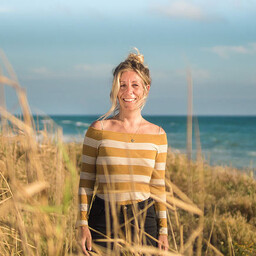
Jana is responsible for the website and blog at A-Frame. As a digital nomad and surf lover, she can work from anywhere in the world. She has currently opted for the Allgäu and El Palmar. For the Allgäu because of the love and for El Palmar because of the waves.
Introduction
"It's like the mafia. Once you're in - your in. There's no getting out."
You know the famous quote from professional surfer, Kelly Slater? Surfing can indeed be "highly addictive", especially for people who enjoy being in the water and in nature. You will realize exactly what this means as soon as you catch your first white water wave. Because as soon as you've surfed your first wave, you'll be stoked. In heaven. The feeling that develops while surfing is indescribable and unique. Surfing makes you happy. So learning to surf is worth it ;-)
The roots of surfing go back deep into history and are closely linked to the culture of many coastal peoples. Originally developed as a spiritual practice and competition, surfing has now evolved into a global passion that unites people of all ages and backgrounds.
When you decide to learn to surf, you are not only embarking on a physical challenge, but also becoming part of a vibrant community of like-minded people. Whether you surf alone, with friends or in a course, the experiences in the water will be unforgettable and will always motivate you to keep learning and getting better.
In this blog post, we will provide you with valuable tips and information to help you successfully immerse yourself in the world of surfing. From choosing the right equipment to the best surf spots and basic techniques, we'll guide you on your way to conquering the waves and experiencing the joy of surfing. Get ready to make learning to surf an unforgettable part of your life!
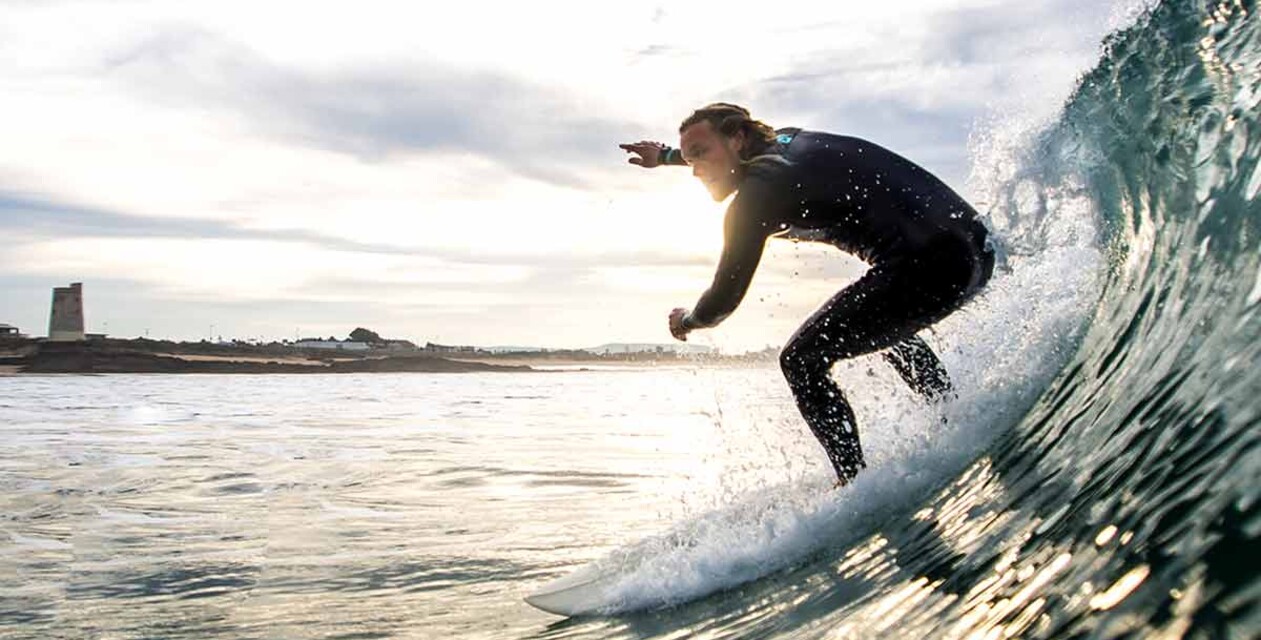
The basics of surfing
Learning to surf starts with a solid understanding of the basics of the sport. But what exactly is surfing and what makes it so special?
Surfing is a water sport that involves standing on a surfboard and riding the power of the waves. The art of surfing combines physical fitness, technique and a keen sense of the water. It's not just about catching the wave, but also about the feeling of freedom and being at one with nature.
The history of surfing goes back to ancient Polynesian cultures, where it was practised as a form of transportation and also as a competition. The first European surfers discovered surfing in the 18th century, and since then the sport has spread worldwide. Nowadays, surfing is not only a popular recreational sport, but also a competitive discipline that includes international events and championships.
Definition & History
What is surfing?
Surfing is the art of riding waves on a surfboard. It requires a mixture of technique, strength and skill. The waves used for surfing are created by wind blowing across the surface of the water and transferring energy into the water. There are different types of waves: from gentle, breaking waves, which are ideal for beginners, to steep and powerful waves, which are mainly suitable for experienced surfers.
An important element of learning to surf is understanding the different types of waves and their characteristics. Beginners should initially focus on gentle waves that make it easier to get up on the board. As you gain experience, you can then move on to more challenging waves.
History of surfing
The history of surfing is rich and fascinating. Originally, the Polynesians in ancient Hawaii practiced surfing, which was used both as a means of transportation and competition. Surfing quickly became an important cultural activity that also had spiritual aspects. In the 18th century, European sailors discovered the fascination of surfing and brought the sport to other parts of the world.
Over time, surfing developed into a worldwide phenomenon. The first surf clubs were founded and the sport gained popularity, especially in the USA and Australia. In recent decades, surfing has not only established itself as a leisure activity, but has also become increasingly popular in the media, through films and competitions.
When learning to surf, it is important to keep this history in mind. It shows how deeply rooted the sport is in different cultures and how it brings people together. By understanding the cultural significance of surfing, you can build a deeper connection to this fascinating sport and appreciate the experience of surfing even more.
By understanding and practicing these surfing basics, you'll progress quickly and be ready to take your surfing to the next level. In the following sections, we'll look at specific topics such as equipment, techniques and safety to help you learn to surf in the best possible way. Immerse yourself in the fascinating world of surfing and experience the freedom that only the waves can offer!
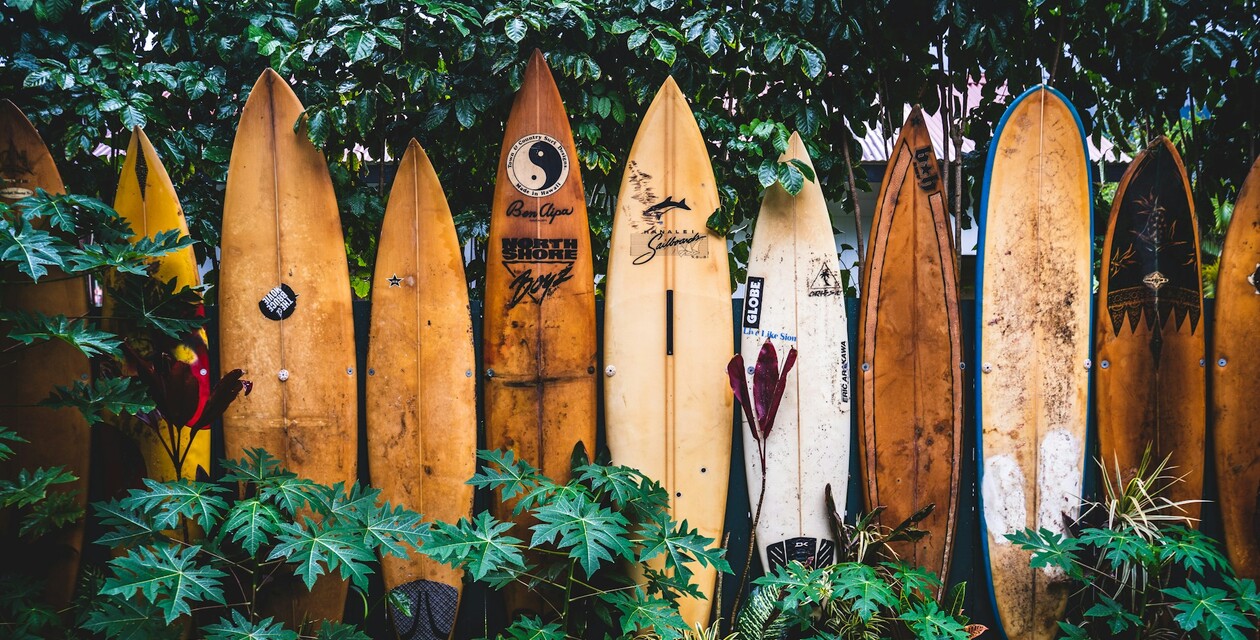
Equipment for learning to surf
The right equipment is crucial when it comes to learning to surf successfully. Whether you're a beginner or slightly more experienced, choosing the right equipment can make a big difference to your learning success and surfing enjoyment. In this section, we look at the key pieces of equipment you'll need to start your surfing journey.
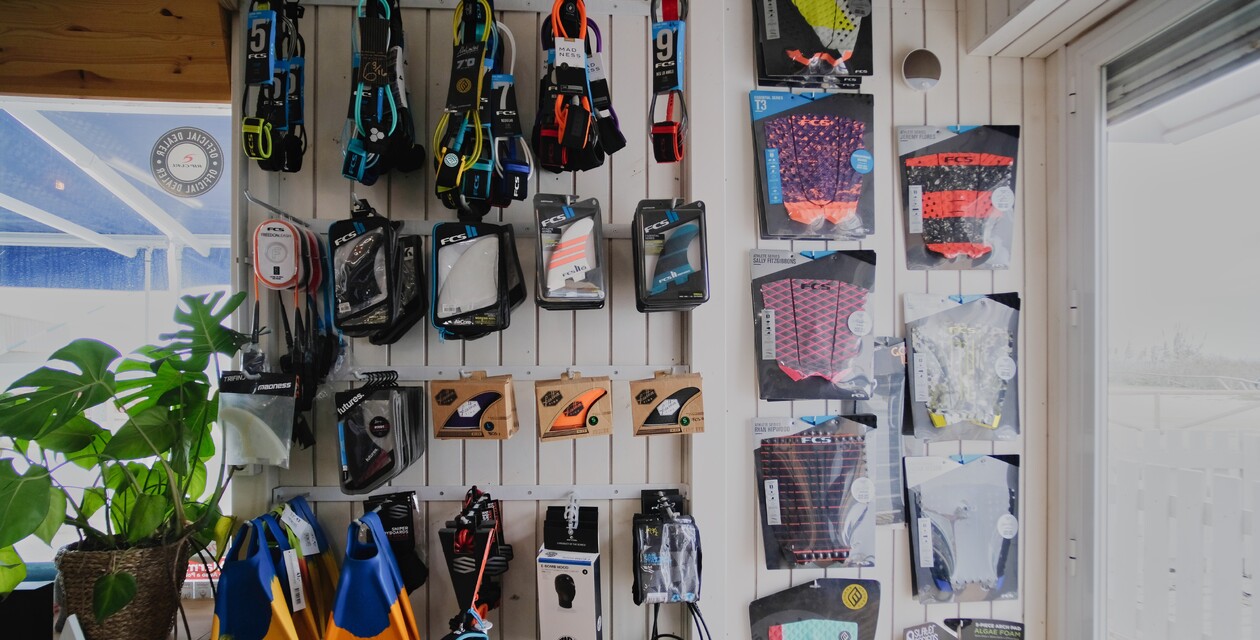
Surfboards, wetsuits & accessories
Surfboards: Types and selection
The surfboard is the central element of your surfing equipment. There are various types of surfboards that differ in shape, size and material. Here are the most common types:
Soft-top boards: These boards are ideal for beginners as they have a soft top that cushions falls and minimizes the risk of injury. They offer a wide standing surface and plenty of buoyancy, making it easier to stand up.
Funboards: A mix of shortboards and longboards, funboards are versatile and offer a good balance between stability and maneuverability. They are perfect for beginners who are learning to surf and want to progress at the same time.
Shortboards: These boards are shorter and more maneuverable, but are more suitable for advanced surfers. Beginners should initially focus on soft-top or fun boards to practise paddling and standing up.
Longboards: These larger boards are very stable and are ideal for gentle waves. Longboards are ideal for beginners who want to learn the basics of surfing, as they offer a large surface area and make it easier to balance.
Choosing the right board depends on your weight, height and the surf spot you're surfing. It is advisable to seek advice from a surf store or surf school to find the right board for your needs.
Neoprene wetsuits: Why they're important
A wetsuit, also known as a wetsuit, is an important part of your surfing equipment, especially in colder waters. It provides warmth and protects your body from the cold, wind and possible injuries. Here are some reasons why a wetsuit is important:
Warmth protection: Wetsuits insulate your body and keep you warm, even when the water is cool. This is particularly important if you're in the water for a long time, as cold can quickly lead to exhaustion.
Protection from injury: A wetsuit protects your skin from scratches from the board, sharp reefs or jellyfish. This is particularly useful if you are surfing in areas where such dangers can occur.
Improved mobility: Modern wetsuits are designed to offer plenty of freedom of movement. This allows you to move freely while surfing and keep your balance better.
When choosing a wetsuit, pay attention to the thickness of the material, which varies depending on the water temperature. Thinner wetsuits (2-3 mm) are ideal for warmer water, while thicker wetsuits (4-5 mm) are recommended in colder conditions.
Accessories: leashes, wax and more
In addition to the surfboard and wetsuit, there are some important accessories you need to learn to surf successfully:
Leash: A leash is a safety strap that connects your surfboard to your leg. It ensures that the board doesn't drift away from you if you fall and minimizes the risk of injury to you and other surfers in the water. It's important to choose a leash that fits the length of your board.
Wax: Surfboard wax is applied to the top of your board to increase grip and prevent you from slipping. Wax is available in different varieties, depending on the water temperature. Make sure to choose the right type of wax for the conditions you're surfing in.
Surf bag: A surf bag protects your board during transportation and storage. There are different types of bags, including padded bags that offer extra protection and lighter bags for traveling.
Sun protection: Don't forget to protect yourself from the sun! A waterproof sunscreen is essential to avoid sunburn, especially if you're in the water for a long time.
The right equipment plays a crucial role in learning to surf. By investing in high-quality products, you not only increase your comfort, but also your safety and fun in the water. With the right surfboard, a suitable wetsuit and the necessary accessories, you'll be perfectly equipped to conquer the waves and start your surfing journey!
Surf spots for beginners
Choosing the right surf spot is crucial if you want to learn to surf. Different beaches offer different conditions that are suitable for beginners. In this section, we'll look at the best surf spots for beginners, the criteria for choosing a surf spot and local surf schools and camps.
Find a surf spot
The best beaches to learn to surf
An excellent place to learn to surf is El Palmar. Jokes aside, El Palmar is actually a great place to learn to surf. The beach stretches for miles and offers waves that are ideal for beginners all year round. The so-called beach break is particularly beginner-friendly, which means that the bottom is made of sand. In contrast to reef breaks, where the water breaks over reefs or rocks, the risk of injury is low here. There are no dangerous currents in El Palmar, so beginners can concentrate on learning the basics without having to worry too much. These conditions make El Palmar a great surf spot to learn to surf and celebrate your first successes.
Some other recommended surf spots for beginners are:
Canggu, Bali: Canggu offers gentle waves and numerous surf schools that are specifically geared towards beginners. The beach is ideal for those who want to take their first steps in surfing.
Kuta, Bali: Kuta is known for its long, breaking waves that are perfect for beginners. Here you'll find a vibrant surf culture and plenty of schools to help you get started.
Fistral Beach, Cornwall: This beach in the UK is a popular spot for beginners. It offers a variety of conditions and has a friendly atmosphere that makes learning to surf easier.
Criteria for choosing a surf spot
When choosing a surf spot, you should consider some important criteria to ensure that the conditions are suitable for beginners:
Wave height: Make sure that the waves are not too high or too steep. Waves between 0.5 and 1.5 meters are ideal for beginners, as they offer enough buoyancy without being overwhelming.
Bottom: Beaches with a sandy bottom are the safest for beginners. Beach breaks are usually the best choice as the risk of injury is minimized. Avoid spots with jagged reefs or rocks.
Currents: Find out about the currents at your chosen surf spot. Avoid places with strong currents or dangerous conditions that could overwhelm you.
Crowded: Crowded beaches can be a challenge for beginners. Choose quieter spots or times to give you more space to practice.
Local surf schools and camps
Another important aspect of learning to surf is the support of local surf schools and camps. These not only offer beginner courses, but also the opportunity to exchange ideas with like-minded people and receive valuable tips from experienced surfers.
There are numerous surf schools in El Palmar that offer tailor-made courses for beginners. Here you will learn the basics of surfing, from paddling technique to standing up on the board. The instructors are often experienced surfers themselves and can give you valuable insights to help you progress more quickly. Our surf camp, A-Frame Surfcamp, is located right on the beach and offers first-class surf lessons as well as fantastic full board and cozy accommodation.
By choosing the best surf spots and contacting a local surf school, you'll be well on your way to learning to surf successfully. Take advantage of the ideal surroundings of El Palmar and let yourself be infected by the fascination of surfing!

Tip: Learn to surf at the A-Frame surf camp
Our surf camp and surf school are located in the south of Spain, in El Palmar to be precise. This is a charming little coastal town in Andalusia on the Costa de la Luz. Here, the Atlantic Ocean gives us wonderful waves for surfing and learning to surf. The 8 km long beach break is beginner-friendly and ensures that you will always find a fairly empty peak to learn to surf. Due to its proximity to Africa (only 14 km away), the sun almost always shines here and ensures that it is usually a mild 20 degrees even in winter.
In El Palmar, the vibe is relaxed and the clocks tick slower. You can slow down and enjoy the sea and nature here. Long walks on the beach, surfing, yoga and excellent food await you when learning to surf in El Palmar.
Surfing techniques for beginners
Learning to surf is an exciting journey that requires a lot of practice and patience. To master the basics of surfing, it's important to learn some fundamental techniques that will help you navigate the water safely and efficiently. In this section, we'll look at the basic surfing techniques that every beginner should master.
Learning to surf - first steps: attaching the leash
Before you go into the water, you need to find out which leg you are attaching your leash to. This depends on whether you surf "goofy" or "regular". You may know this from snowboarding. It means whether your right foot is in front (goofy) or your left foot is in front (regular). Your surf instructor will do a few tests with you to find out. But you can also try out now whether you surf goofy or regular:
Stand with your back to a person and ask them to push you with a short swing. Normally, the leg that swings forward first in the reflex is your front leg on the surfboard.
No matter how the tests described here turn out, in the water you will quickly notice which foot is in front. After the first few attempts to stand up, you will recognize which foot is easier to get forward on the surfboard. The leash will later be attached to the foot of the rear leg.
Learning to surf safely - The Safety Intro
At the start of your surf course, you will be given a wetsuit and a surfboard for beginners - a so-called soft-top surfboard. Then you'll go to the beach in small groups with your surf instructor. We'll show you a few safety tips so that you don't injure yourself:
Make head protection
Even if the soft board is relatively soft and the surfboard fins are flexible, you should wear head protection if you fall off your surfboard. This is important to avoid head injuries and cuts. Your surf instructor will attach particular importance to this protection and to ensuring that it is carried out correctly. So head protection!!! Always!
Never carry the surfboard between you and the wave
When you are in the water with the surfboard, always hold the surfboard next to your body and not across in front of you. This way, you ensure that the board doesn't "fly" into your face when the next wave hits.
Keep your distance
If you go into the water as a group, you should leave enough space for the others next to you. As the board is already relatively long and the leash should usually be at least as long as the surfboard, each surf student takes up quite a bit of space. That's why you leave about 4-5 meters of space between each student so as not to disturb the others while practicing and to avoid accidents or crashes. So you stand next to each other in the water and try to get your first waves. You should never start the wave standing behind each other. Because then you are practically in each other's line of fire and the risk of accidents is greater. Even if it's cool to surf together, you should always keep a certain distance from your surf buddy.
Always attach and detach the leash on the beach
The leash is the strap that is attached to your back leg with Velcro and connects you to the board. This prevents you from losing the surfboard if you fall off the board. If this connection between surfer and board is removed in the water, the board will drift away from us and your "life raft" surfboard will no longer be there. Therefore: Always attach and detach the leash on the beach.
Tip: It's best not to grab the leash in the water, as it can get wrapped around your hand or fingers. Then the next wave will pull on it and this can be very painful.
The right warm-up
As with all other sports, warming up is a very important part of surfing. The circulation is stimulated, muscles are supplied with blood and joints are lubricated. This prepares the body for physical exertion. Above all, however, it prevents injuries. Surfing is a strenuous sport, even if it looks easy on TV or You-Tube. You'll know what we mean when it comes to paddling at the latest. ;-)
Gliding
After the introduction and warm-up, it's finally time to get into the water! But don't worry, you don't have to plunge into the big waves straight away. We normally start in what is known as white water. This means that a wave breaks and then rolls onto the beach as a "white water wave". This wave is ideal for practising your first steps.
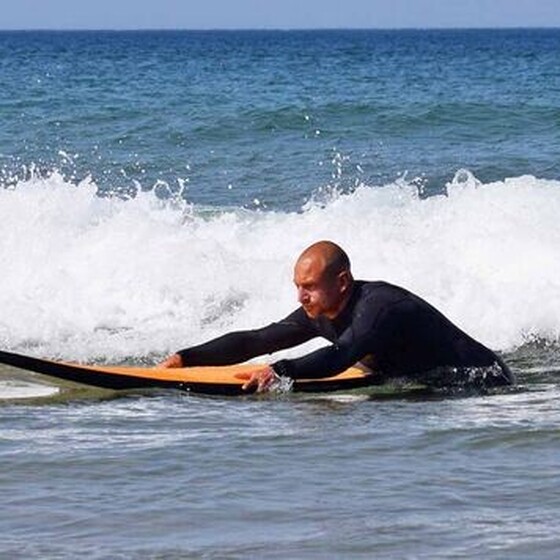
Gliding A - Surfing on the belly
The first gliding exercise is very simple and really fun. You don't have to stand up yet, just surf on your stomach. Here's how it works:
You walk with the surfboard next to your body into the water, which is about waist-high. The tail (rear part) of the board points towards the sea, the nose (front part) towards the beach.
Now wait until a white water wave approaches.
If white water is in sight, turn your body towards the beach and wait until the wave is about 30 cm away from the tail.
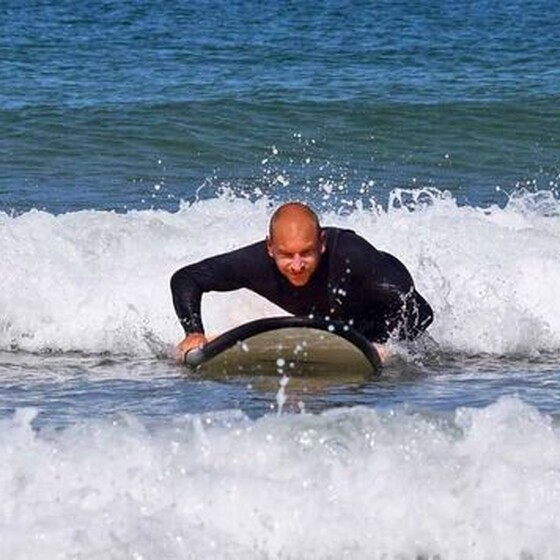
Lying position
Now push the board into the wave. You "hop" into a lying position on the board...
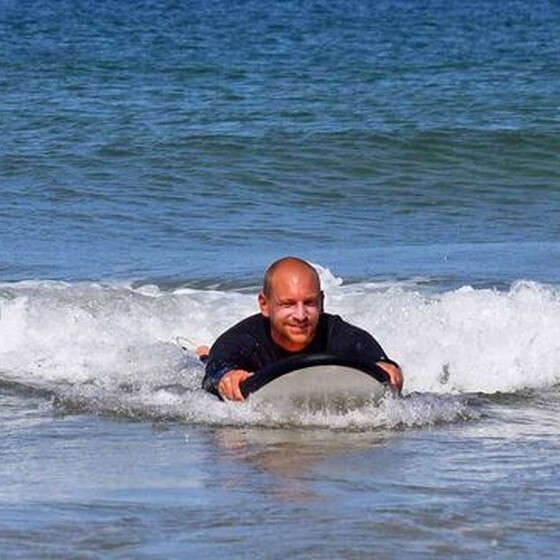
Surfing on the beach
and surf on your stomach all the way to the beach. :-)
You should not stand up yet, but get used to the feeling on the board.
Once you've done that, you'll have surfed for the first time, yay! You'll realize how much speed you can achieve on a surfboard like this and what kind of power there is in the ocean. Gliding A is also great for getting used to the board and handling it.
Gliding B - Find the sweet spot, brake and accelerator pedal
Gliding B teaches you how to regulate the brake and accelerator pedal. Also the correct position on the board.
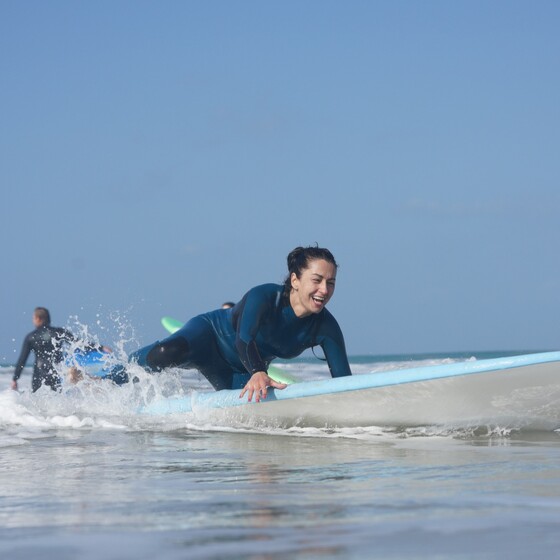
Brake & gas pedal pedal
A typical beginner's mistake in surf lessons: when gliding on the belly, many students put their hands on the rails towards the nose to hold on. You don't have to feel bad, most of us do this intuitively. What many don't know: They unconsciously press on the "gas pedal". (A little mnemonic from Alex: front load - "accelerate", rear load - "brake") To prevent unintentional accelerating and braking, there's a great exercise called Gliding B.
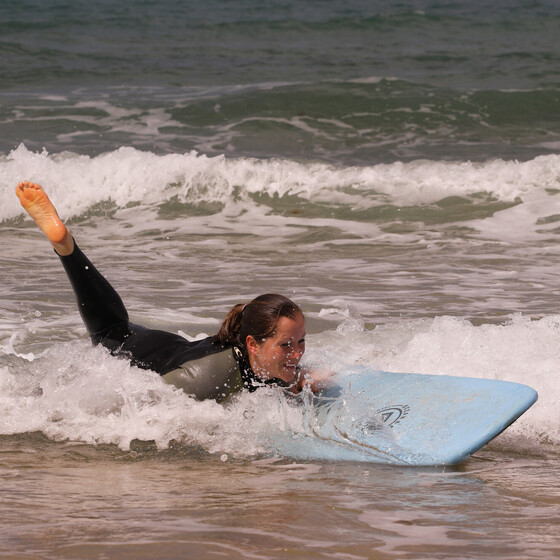
The right position on the board
Gliding exercise B is also about finding your so-called "sweet spot". This is your optimal position on the board. If your body is too far forward, the nose may dip when the wave starts (nose dive). If you are too far back, you will slow down the board so that you are not caught by the wave.
This exercise therefore kills two birds with one stone: you prevent this unintentional acceleration and you automatically have to look for your "sweet spot" to find an optimal planing position. Here we go:
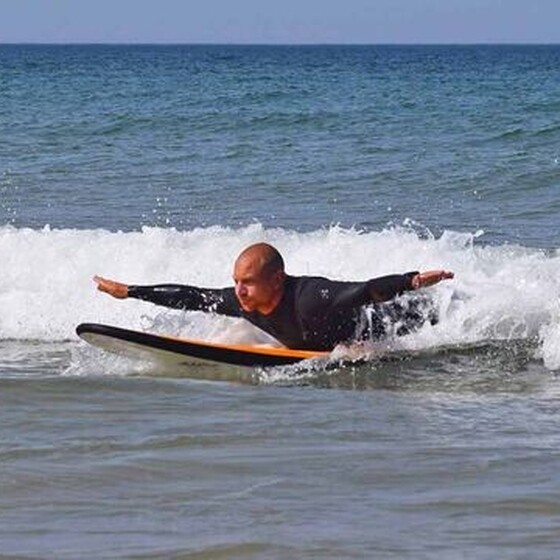
How gliding B works
You start as in Gliding A.
When the white water comes towards you, lie back on your surfboard
You also remain on your stomach for this exercise
But: Pay attention to your arms: keep them stretched out to the side of your body - like an airplane.
Make sure you build up as much body tension as possible to remain stable on the board. Feet together, chin and chest lifted, gaze straight ahead. Quite a lot at once, but you'll see: After a few successful attempts, everything will become automatic and you will be able to incorporate your first steering maneuvers. Simply lean to the right or left when riding down the wave. This puts weight on the respective rail and you'll already be riding your first turn. On your stomach, of course.
Gliding C - Paddling & gliding support
In this gliding exercise, it's finally time to paddle!
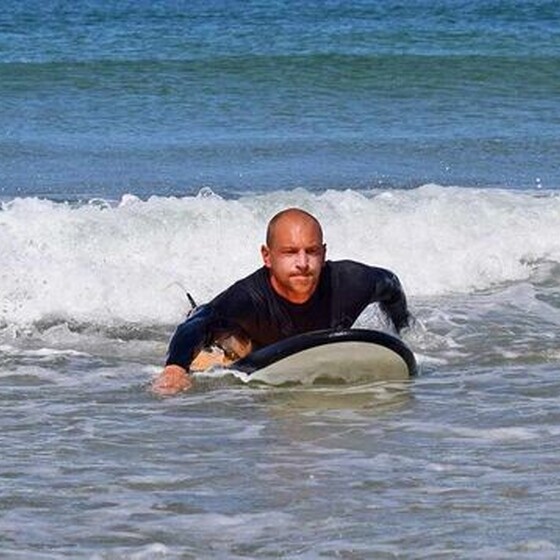
Paddling
You start like exercises A and B.
In contrast to gliding A or B, you don't push the board into the wave and don't jump into the lying position, but you lie down on your surfboard and try to generate your own speed by paddling. You need to generate enough speed for the wave to take you with it.
The timing changes for this exercise: You no longer start when the white water wave is 30 cm away, but when it is still approx. 3 - 4 meters away. Otherwise, you won't be able to pick up enough speed.
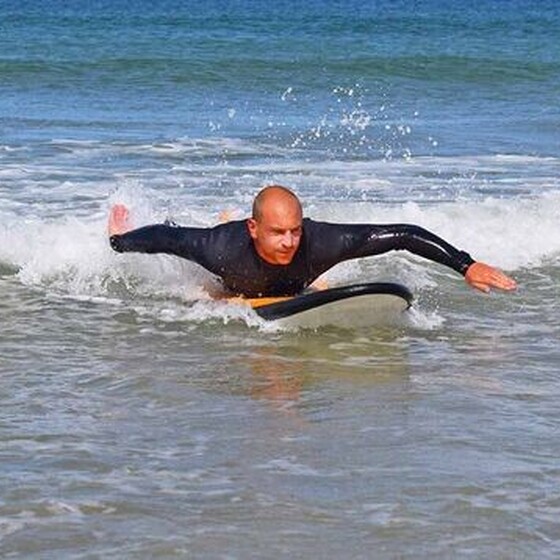
Paddling 2
Then lie down on your "sweet spot" on the board and start paddling (with enough body tension).
When you are then hit by the tail of the wave, follow up with 2 - 3 powerful paddle strokes to catch the wave.
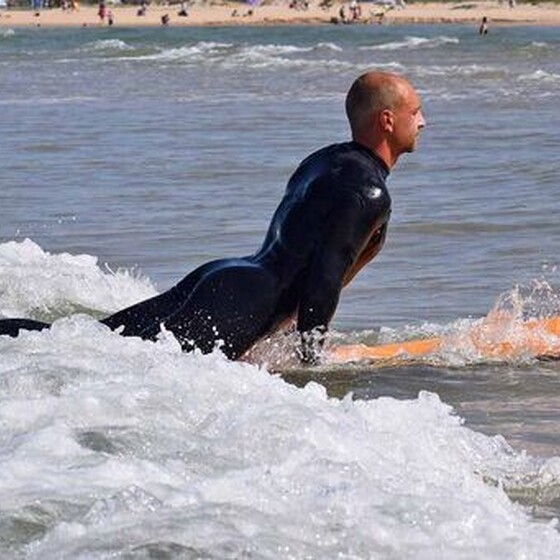
Sliding support
Once the wave has taken you, go into the so-called "gliding support". Place your hands on your surfboard close to your ribcage (like a cobra in yoga). Then push yourself up from the board with your arms stretched out, roughly up to your hips. Your center of gravity is on your hands. In this position, you can easily surf all the way to the beach. The rail support is the first step of the take-off and is therefore very important for standing up on the board one day. :-)
Tip from Alex: Strength lies in calm! Paddling should be a calm, coordinated movement. Hectic, small strokes don't achieve much. Long pull and push movements are much more efficient and energy-saving.
Basics of paddling technique
Paddling technique is the first step to getting into the water and catching waves. A correct paddling technique is crucial to save energy and be fast enough to reach the waves. Here are some tips for proper paddling technique:
Body position: Lie on your stomach on the board so that your body is well balanced. Your feet should extend slightly over the end of the board to ensure stability. Keep your head up to see the waves.
Paddling: Use your arms to paddle the water with a strong, steady motion. Bring your hands into the water in an arc so that you build up enough strength with each paddle stroke. Alternate arms to make steady progress.
Body rotation: Make sure to rotate your upper body slightly to use the power from your torso. This helps to make your paddling movements more efficient.
A good paddling technique is crucial to getting into the right position in the water and increasing your chances of catching the wave.
Standing up on the board (pop-up technique)
Standing up on the board, also known as a pop-up, is one of the most exciting moments when learning to surf. It requires both technique and body control. Here are the steps to successfully stand up on the board:
Wave catches: When paddling a wave, make sure you time it right to get on the wave. You should make a powerful paddle stroke as the wave builds up behind you.
Pop-up move: As you lie in position, use your hands to support yourself. Pull your legs under your body at the same time, with your feet shoulder-width apart. Your hands should be placed next to your chest.
Get up quickly: Push off forcefully with your arms and pull your legs under your body at the same time. Squat down quickly and straighten up to stand on the board. Make sure your weight is evenly distributed.
Keep your balance: Once you're standing, bend your knees slightly and keep your upper body upright. Look in the direction you want to go and use your arms to stabilize yourself.
It may take a few attempts to get the pop-up right. Practice is the key here - the more times you try, the better you'll get at it.
The take-off in pictures

Step 1
First, do the gliding support that you already learned in the last gliding exercise.

Step 2
Turn your hips and bring your back foot to your knee. (The Regular Surfer turns onto the left hip, the Goofy onto the right. At the same time, place the back foot at an angle, flat, next to the opposite knee.
From this position, step 3 follows.

Step 3
You step forward with your leg still outstretched.
Reading and understanding waves
Another important aspect of surfing is wave reading. To learn to surf successfully, it is important to understand the waves and their movements. Here are some tips for reading waves:
Watch the waves: Take time to watch the waves before you get in the water. Pay attention to how they break and which direction they take. This will give you clues as to where the best waves to catch are.
Understand the spot: Every surf spot has its own special features, such as currents, wind directions and bottom conditions. Find out about the conditions of the spot to better assess where you can paddle and catch waves.
Timing is everything: The right timing is crucial to catching a wave. Watch out for the moment when the wave builds up and start paddling to reach the wave before it breaks.
Positioning: Position yourself in the right place in the water to make the most of the waves. Try to stay close to the breaking wave, but not directly in danger of hitting it.
Reading waves is a skill that you will develop over time. The more time you spend in the water, the better you will become at choosing the best waves for you and surfing them successfully.
Conclusion
This all sounds complicated, but after a few dry runs on the beach, it's easier than it sounds. It is important that the front foot is placed at the same height as the hands were previously placed. The back foot is at a 90 degree angle on the surfboard, the front foot at a 45 degree angle. Now all you have to do is bend your knees, look towards the beach and activate your arms at the side of your body. It's best to practise all this on the beach first. In surf lessons, we always do lots of dry runs before we go into the water.
If you follow these tips, nothing stands in the way of a successful wave ride. :-)
It doesn't matter whether you stood up or not on your first attempt at surfing. The most important thing is to have fun surfing. Above all, try to enjoy the time you spend in the water. The rest will come naturally. Learning to surf is above all practice. If you practise a lot and implement the feedback from your surf instructor, it will work.
And don't forget: "The best surfer out there is the one having the most fun." - Phil Edwards
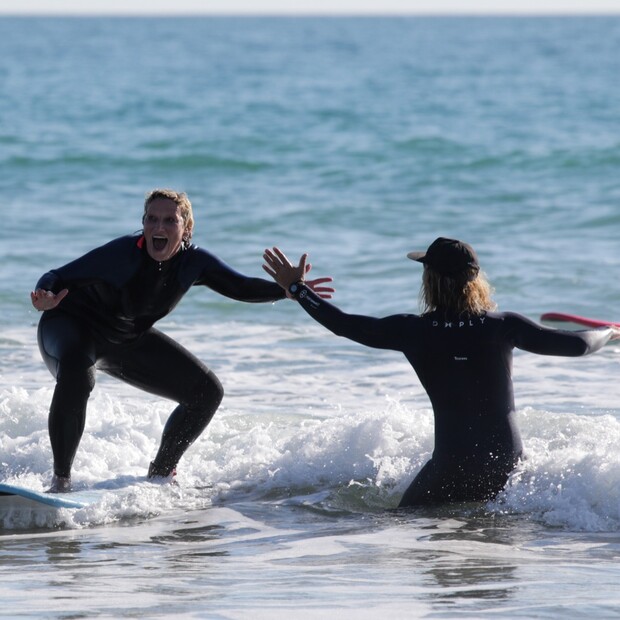
Excursus: Why do we recommend the 3-step take-off?
There are various natural take-off methods. Do you know the jump take-off, for example? As the name suggests, you jump sideways onto the board and try to land correctly straight away. Why do we teach the 3-step take-off?
Because you can break the movement down into individual steps. This is often particularly useful for beginners. For example, if you have a problem with step 2, you can always continue the movement through to the second step and then simply ride onto the beach. This is because your center of gravity is still on your hands despite the hip rotation and bent knee (keyword: glide support). This is the big advantage of the 3-step day-off.
We achieve the greatest learning success with this method. Of course, if you prefer the jump take-off, that's no problem either ;-)
Green wave surfing
Yay, you've stood your first wave. Most people find the feeling indescribably beautiful and naturally want more of it. As soon as you have mastered the take-off, the next step in learning to surf comes: surfing the green wave. This step is part of the advanced surf course, the so-called intermediate surf course.

Advanced surfing techniques
Once you've mastered the basics of surfing, it's time to take your skills to the next level and learn advanced surfing techniques. These techniques will help you ride the waves with more style and precision and make your surfing experience even more exciting. Here are some advanced surfing techniques you can develop as you learn to surf.

Duck-Dive, Cutbacks & Turns
Duck Dive and Turtle Roll
When learning to surf, you will come across larger waves where it is important to know how to dive under them. Two basic techniques for this are the duck dive and the turtle roll.
Duck Dive: This technique is ideal for shorter boards. With the duck dive, you dive under the wave to avoid its lift. Push the nose of your board down while simultaneously lifting your back leg up to sink the tail. Once you're under the wave, pull the nose up and let the wave pull you through.
Turtle roll: This technique is better suited to longer boards and beginners. With the turtle roll, you turn yourself and your board 180 degrees so that you can dive under the wave. Hold on tight to the rails of your board to keep yourself stable.
Bottom turn and top turn
The bottom turn and top turn are basic maneuvers that help you make the most of the wave and build up speed.
Bottom turn: This technique is the first turn you make after you get on the wave. Bend your knees and shift your weight to the back edge of your foot while turning your front foot forward to initiate the turn. This will help you gain speed and prepare for the next turn.
Top turn: After you've completed the bottom turn, it's time for the top turn. Shift your weight onto your front foot and turn your shoulders in the direction you want to go. Use your back hand to guide the tail of your board. The top turn allows you to control the wave and perform stylish maneuvers.
Cutbacks and re-entries
Cutbacks and re-entries are advanced maneuvers that help you take advantage of the entire wave and improve your surfing style.
Cutback: The cutback is a maneuver in which you ride from the shoulder of the wave back into the steeper part of the wave. Start with a powerful bottom turn and then turn back to the wave by shifting your weight to the back edge of your foot. Pull the nose of your board up and turn towards the wave to complete the cutback.
Re-entry: The re-entry is a challenging maneuver in which you ride from the face of the wave back onto the crest. Start with a strong bottom turn and then align yourself with the crest of the wave. Shift your weight forward and turn your board to hit the lip of the wave. Use the power of the wave to bring you back into the face of the wave.
Tube riding
Tube riding is probably the ultimate surfing experience and an advanced technique that requires a lot of practice. Here you ride into the inside of the wave, the so-called "green room".
Tube riding: To ride a tube, you need a fast, hollow wave. Start with a quick bottom turn to gain speed and then position yourself so that the lip of the wave breaks over you. Keep your weight centered and use small movements to maintain your position in the tube. The goal is to stay in the tube as long as possible and eventually come out safely.
By practicing and perfecting these advanced techniques as you learn to surf, you'll improve your skills and enrich your surfing experience. Surfing is an art that requires constant development and dedication. Stay patient, practice regularly and enjoy every wave you ride.
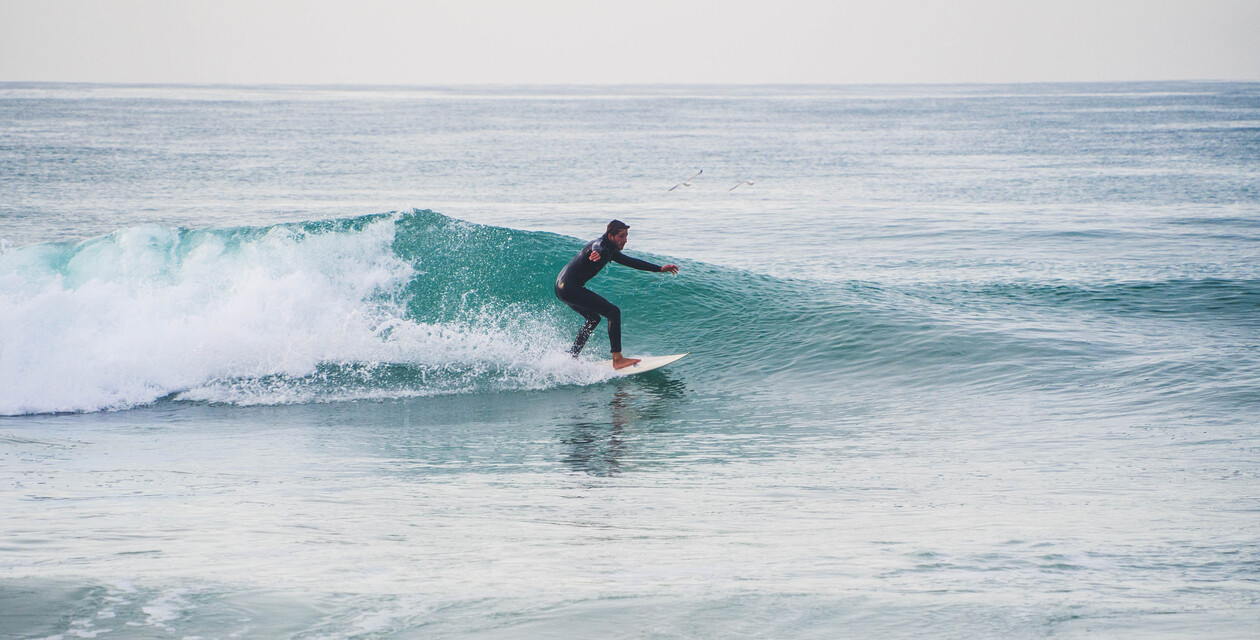
Learning to surf safely
When learning to surf, safety is a crucial factor that should not be neglected. Whether you're a complete beginner or an advanced surfer, it's important to follow certain safety guidelines to avoid injury and ensure a positive surfing experience. In this section, we'll look at the basics of safety, rules of conduct in the water and first aid measures.
Safety, rules of conduct, first aid
Basic safety rules
When learning to surf, you should follow a few basic safety rules that will help you stay safe in the water:
Know your limits: Don't overestimate your abilities. Start with small, gentle waves and slowly work your way up to larger waves. If you feel unsafe, get out of the water and observe the conditions before trying again.
Never surf alone: Beginners in particular should never surf alone. It is always better to surf with a friend or in a group. This way, you can get help in an emergency and are safer in the water.
Wear a leash: The leash connects you to your board and prevents the board from drifting away from you. This is particularly important to avoid injuring other surfers and to keep your board with you.
Watch the weather conditions: Find out about the current weather and water conditions before you go into the water. Strong winds, high waves and currents can be dangerous, especially for beginners.
Rules of conduct in the water
When learning to surf, it is important to know and respect the rules of conduct in the water. These rules help to avoid accidents and promote harmony in the water:
Right of way: The surfer closest to the breaking wave has the right of way. Respect this rule to avoid collisions. Wait until the wave is clear before trying to surf it.
Don't push: Wait patiently for your chance to catch a wave. Don't push yourself into the position of another surfer who is already waiting for the wave.
Communication: Communicate clearly with other surfers in the water. When you catch a wave, shout "Left!" or "Right!" to let others know which way you're going.
Avoid dangerous areas: Stay away from busy areas and surf zones that are unsuitable for your skills. Respect the areas designated for beginners, intermediates and experts.
First aid measures
Accidents can happen while surfing, so it's important to know some basic first aid measures. When learning to surf, you should know how to react in an emergency:
Treating injuries: Small cuts and abrasions can often occur when surfing. Clean the wound immediately with clean water and cover it to avoid infection.
Unconsciousness: If someone falls unconscious in the water, get help immediately. Remove the person from the water and check their breathing and pulse. If necessary, start resuscitation and call the emergency services.
Fall injuries: Serious falls can cause injuries to the head, neck or back. Do not move the injured person unnecessarily and wait for professional help. Keep them warm and calm.
Sunstroke and dehydration: Surfing can be exhausting, especially in the sun. Make sure to drink enough water and take breaks in the shade to avoid sunstroke and dehydration.
By following these safety guidelines and rules of conduct and knowing basic first aid measures, you can approach learning to surf safely and responsibly. Safety is the key to a positive and carefree surfing experience that will stay with you for a long time.
Physical and mental preparation
When learning to surf, it's not just technique that plays an important role, but also physical and mental preparation. Good physical fitness and a positive mental attitude can significantly speed up the learning process and make surfing an even more fulfilling experience. In this section, we look at how you can prepare yourself physically and mentally to learn to surf.
Preparation is everything
Physical fitness and warm-up exercises
Surfing is a physically demanding sport that requires strength, endurance and flexibility. Good physical preparation can help you progress faster and avoid injury. Here are some tips to improve your physical fitness and warm-up exercises before surfing:
Strength training: Strengthen your muscles, especially in the arms, shoulders, core and legs. Exercises such as push-ups, planks, squats and lunges are particularly helpful.
Endurance training: Surfing requires a lot of paddling, which requires good endurance. Endurance sports such as swimming, running or cycling improve your stamina and prepare you for longer sessions in the water.
Flexibility: Good flexibility is important for getting up on the board quickly and efficiently. Regular stretching and yoga can improve your flexibility and prevent injuries.
Warm-up exercises: Before you get into the water, you should warm up to prepare your body for the effort ahead. Some effective warm-up exercises are:
Arm circles: Circle your arms in large movements to loosen your shoulders.
Torso rotations: Rotate your upper body to the left and right to activate your core muscles.
Leg swings: Swing your legs back and forth to loosen up your hip muscles.
Stretching exercises: Stretch your legs, arms and back to increase flexibility.
Mental preparation and attitude
Learning to surf can sometimes be frustrating, especially when progress seems slow. A strong mental attitude is therefore just as important as physical fitness. Here are some tips for mental preparation:
Set realistic goals: Set yourself small, achievable goals and be happy about any progress. This helps to keep you motivated and avoid frustration.
Visualization: Imagine yourself successfully standing on the board and riding the waves. Visualization can boost your self-confidence and help you understand the movements better.
Patience and perseverance: Learning to surf takes time and perseverance. Be patient with yourself and accept that setbacks are part of the learning process. Every wave is a new opportunity to learn.
Breathing and relaxation: Surfing can be exhausting, so it's important to stay calm in stressful situations. Focus on your breathing and try to relax, even when things don't go to plan.
Positive attitude: A positive attitude can make a big difference. Enjoy the learning process and have fun learning new skills. Every experience in the water is valuable, whether you ride a wave or not.
By preparing yourself both physically and mentally to learn to surf, you will be better able to overcome the challenges and progress faster. Surfing is not just a sport, but also a journey to yourself - and this journey begins with the right preparation.
Common mistakes when learning to surf
Learning to surf is an exciting and challenging journey that requires both patience and dedication. During the learning process, many beginners make similar mistakes that can delay their progress. Here are some common mistakes when learning to surf and how you can avoid them.
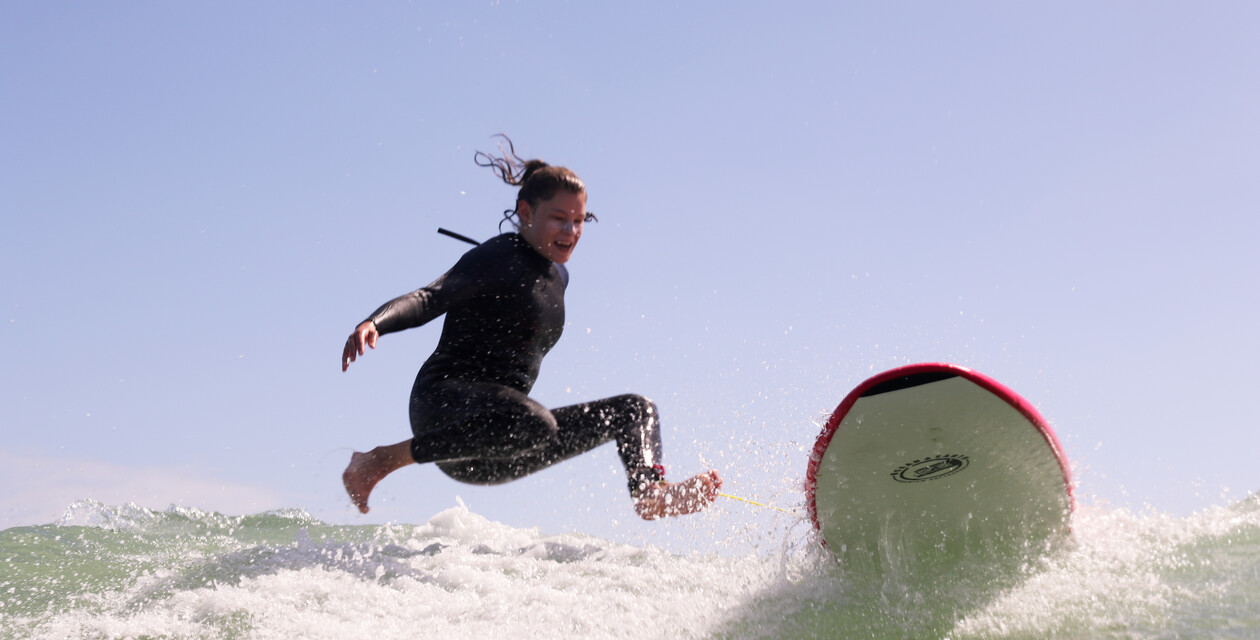
Avoid the following mistakes
1. Wrong board choice
One of the most common mistakes when learning to surf is choosing the wrong surfboard. Beginners often tend to choose a board that is too small or too advanced. A larger, wider board offers more stability and buoyancy, which makes it much easier to stand up and catch waves. Soft-top boards are ideal for beginners as they are soft and safe.
2. Poor paddling technique
Paddling technique is crucial to catching waves and moving through the water. Many beginners paddle inefficiently by making strokes that are too short or too shallow. Be sure to make long, powerful paddle strokes and rotate your body slightly to harness more power. An effective paddling technique will help you progress faster and with less effort.
3. Wrong timing when standing up
The correct timing when standing up on the board (pop-up) is essential. Many beginners try to pop up either too early or too late, causing them to miss the wave or lose their balance. Practice timing by watching when the wave carries you and then getting up quickly. A well-executed pop-up is the key to a successful ride on the wave.
4. Lack of balance and body tension
Balance is crucial when learning to surf. Beginners tend to stand too stiffly on the board or distribute their weight incorrectly. Bend your knees slightly and keep your upper body upright to keep your balance better. Keep your arms relaxed and use them to stabilize yourself. Good body tension will help you stand more stable on the board and control the waves better.
5. Neglecting to read the waves
Reading and understanding the waves is an art that takes time and experience. Many beginners paddle blindly into the waves without considering the conditions. Take time to observe the waves and learn how they break and move. Proper wave reading will help you choose the best waves for your level and surf more efficiently.
6. Paddling too far out or in
Proper positioning in the water is crucial to catching waves. Beginners often paddle too far out and miss the waves or too far in where they get overrun by the breaking waves. Find the right balance by watching the waves and adjusting your position accordingly. Good positioning will increase your chances of making the most of the waves.
7. Impatience and frustration
Learning to surf requires patience and perseverance. It's normal to have difficulties and setbacks at the beginning. Many beginners quickly become frustrated and lose motivation. Stay patient and positive, and remember that every little bit of progress counts. Enjoy the learning process and your time in the water rather than just focusing on quick wins.
By avoiding these common mistakes when learning to surf and continuously working on your skills, you will progress faster and enjoy surfing more. Surfing is a lifelong journey where there is always something new to learn and discover. Keep at it, practice regularly and enjoy every wave you ride.
Learn to surf on vacation
The exercises described above for learning to surf are of course no substitute for a real surf course on your surf vacation. If you want to learn to surf, book a week's surf camp or simply a surf course (for example at our A-Frame surf camp in El Palmar). We will be happy to teach you how to surf at our surf camp. In addition to a surf course with excellent instructors, we are happy to spoil you with fantastic culinary delights. You'll stay in cozy Andalusian accommodation with everything you need. As our surf camp is located very close to the beach, you'll have your toes in the sand in just a few steps. Simply carry your surfboard across the street and off you go to learn to surf.
Tip: Learn to surf in Spain, El Palmar
Our surf camp and surf school are located in the south of Spain, in El Palmar to be precise. This is a charming little coastal town in Andalusia on the Costa de la Luz. Here, the Atlantic Ocean gives us wonderful waves for surfing and learning to surf. The 8 km long beach break is beginner-friendly and ensures that you will always find a fairly empty peak to learn to surf. Due to its proximity to Africa (only 14 km away), the sun almost always shines here and ensures that it is usually a mild 20 degrees even in winter.
In El Palmar, the vibe is relaxed and the clocks tick slower. You can slow down and enjoy the sea and nature here. Long walks on the beach, surfing, yoga and excellent food await you when learning to surf in El Palmar.
Best time to learn to surf
Choosing the best time to learn to surf can have a big impact on your learning experience. Different regions offer ideal conditions for beginners at different times of the year. Here are some factors to consider when choosing the best time to learn to surf:
1. Wave conditions
Smaller, gentle waves are ideal for beginners as they are easier to handle and less intimidating. Find out about the seasonal wave conditions at your preferred surf spot. In many regions, there are certain times of year when the waves are particularly beginner-friendly.
El Palmar, Spain: El Palmar offers good conditions for beginners all year round. Especially in the months from September to May, the waves are smaller and more consistent, ideal for learning to surf.
Bali, Indonesia: The dry season from April to October offers the best conditions for beginners in Bali. The waves are smaller during this time and the weather is consistently sunny.
Hawaii, USA: The summer months from May to September are the best time to learn to surf in Hawaii, as the waves are smaller and less powerful than in winter.
2. Weather conditions
Comfortable weather conditions contribute significantly to a positive surfing experience. Look for warm temperatures and mild weather to enjoy your time in the water.
South Africa: The summer months from November to February offer warm temperatures and pleasant water conditions, perfect for beginners.
Australia: On the east coast of Australia, the months from December to February are ideal for learning to surf, as the temperatures are warm and the waves are beginner-friendly.
Portugal: In Portugal, the months from May to October offer mild weather and suitable wave conditions for beginners.
3. Availability of surf courses
During peak travel times, there is often a greater availability of surf courses and surf camps. This can be particularly helpful if you are planning to take part in an organized surf course.
California, USA: The summer months in California are the best time to take part in surf courses. Many surf schools offer special programs for beginners.
Costa Rica: In Costa Rica, the dry season from December to April is the main season for surf courses. The conditions are ideal and many surf schools offer extensive beginner programs.
Sri Lanka: The months from November to April offer ideal conditions on the southwest coast of Sri Lanka. There are a variety of surf courses for beginners during this time.
4. Avoid overcrowding
Popular surf spots can get very crowded during peak season, which can be overwhelming for beginners. Look for off-peak times to find less crowded beaches and more space in the water.
Morocco: The months from September to November and March to May are ideal to avoid the crowds and still enjoy good wave conditions.
Nicaragua: The low season from May to October offers less crowded beaches and still good wave conditions for beginners.
Conclusion
The best time to learn to surf depends on many factors, including wave and weather conditions, availability of surf lessons and the desire to avoid overcrowding. By taking these factors into consideration, you can choose the ideal time and location for your surfing adventure. No matter where you travel, remember that every wave offers a new learning opportunity and enjoy every minute in the water.
Best time to visit Andalusia

Best time to learn to surf in El Palmar
El Palmar on the Costa de la Luz in Spain is a popular surf spot that offers good conditions almost all year round, especially for beginners. Here are some reasons why El Palmar is the ideal destination to learn to surf and which seasons are best for it:
Good conditions all year round
El Palmar offers waves all year round that are particularly beginner-friendly. The wide, long sandy beach and the relaxed beach break make learning to surf here safe and enjoyable. Unlike many other surf spots, there are no dangerous currents or reefs in El Palmar, which minimizes the risk of injury.
Learn to surf in El Palmar
Autumn and spring: ideal for beginners
The best times to learn to surf in El Palmar are fall (September to November) and spring (March to May). During these months, the waves are usually smaller and less powerful, which creates ideal conditions for beginners. The weather is mild, with pleasant temperatures both in the water and on land, which makes learning and practicing more comfortable.
September to November: After the hot summer, the temperatures are pleasantly warm and the water has heated up over the months. The waves are moderate, perfect for beginners who want to take their first steps on a surfboard. However, it can also get pretty rough. In the surrounding area, there are beautiful dodge surf spots such as Barbate.
March to June: Spring in El Palmar offers similar conditions to autumn, with mild temperatures and moderate waves. The beaches are less crowded as the peak tourist season has not yet started, which means more space and peace and quiet to practice.
Learn to surf in winter
Winter: For advanced beginners
Winter (December to February) can also be a good time to learn to surf in El Palmar, especially for advanced beginners who already have some basic knowledge. The waves can be slightly bigger and more powerful at this time of year, but still offer safe conditions due to the sandy bottom. The beaches are also less crowded in winter, which means more space in the water. But even for absolute beginners, there is always white water to learn to surf. So if you want to learn to surf in winter, you don't have to fly far. Andalusia is warm all year round and wonderfully mild in winter. You can also learn to surf here in December or surf in January or February. Temperatures rarely drop below 18-20 degrees.
Learn to surf in summer
Summer: Lively atmosphere and hardly any waves
Summer (July and August) in El Palmar is a less attractive time to start surfing, as there may be no waves at this time. The beach is quite lively in the summer months and is very crowded due to the vacation season and the influx of tourists. For this reason, we have closed the surf camp during the two peak summer months.
Conclusion
El Palmar offers excellent conditions for learning to surf all year round, with the best times in fall and spring. These seasons offer moderate waves and mild weather, ideal for beginners. Whether you're looking for the challenge of bigger waves in winter or enjoy the relaxed atmosphere in summer, El Palmar is a fantastic place to start your surfing adventures.
Learn to surf costs
The cost of a surf course varies depending on the country and the quality of the surf lesson. You can of course learn to surf very cheaply, but in this case the quality of the surf course is rather doubtful. If you want to learn to surf, you should pay attention to these factors when choosing a surf school:
Small groups
Good surf equipment
Video analysis
Times are based on good conditions
Good surf courses teach in small groups, provide high-quality surf equipment and offer video analysis. Another point by which you can recognize a good surf school is the surfing time. Some surf schools always go into the water at the same time. A sensible surf school or surf camp pays attention to the best surfing conditions for its surf students and adjusts the times daily. You are welcome to get an overview of the costs of our surf camp.
How difficult is it to learn to surf?
In itself, it is not difficult to learn to surf. What is important is body tension, a sense of balance and plenty of practice and routine. But the most important thing is to have fun in the water. Because it can take a few hours of surfing before you surf a real (green) wave. But the time in the water until then is definitely fun. Gliding on the board and surfing white water is also a huge fun factor. Because as pro surfer Phil Edwards said so well: "The best surfer is the one having the most fun".
Is surfing exhausting?
Depending on who you ask, you will definitely get different answers. In Indonesia, for example, surfing is less strenuous because the waves usually break over a reef. This means you often have a so-called channel that you can paddle into the line-up in a relaxed manner. However, you can easily injure yourself when surfing on the reef. Incidentally, it is common practice in many surf schools there to push surf students into the waves instead of teaching them how to paddle out. When choosing a surf school, pay attention to how the instructors work with their students.
In Europe, you sometimes have to work your way out through a few waves first. Paddling into a wave can also be exhausting. But you mustn't forget: You'll be rewarded with one of the best feelings in the world. And surfing is sport after all. And sport is always, at least a little bit, exhausting ;-)
Tip: In Caños de Meca, very close to us, there is a great longboard surf spot with a channel.
Can anyone learn to surf?
In principle, anyone can learn to surf. Of course, you need to be a bit sporty, but surfing is above all practice and fun. Our surf courses include young children, teenagers, parents and grandparents. Guests learn to surf in small groups at our surf camp and surf school. Just give it a try.
When should I start learning to surf?
In our family surf camp, we teach several generations at once. So learning to surf with children is no problem. In the children's surf courses, kids as young as 8 learn how to surf a wave. Because the earlier you start surfing, the better you get.
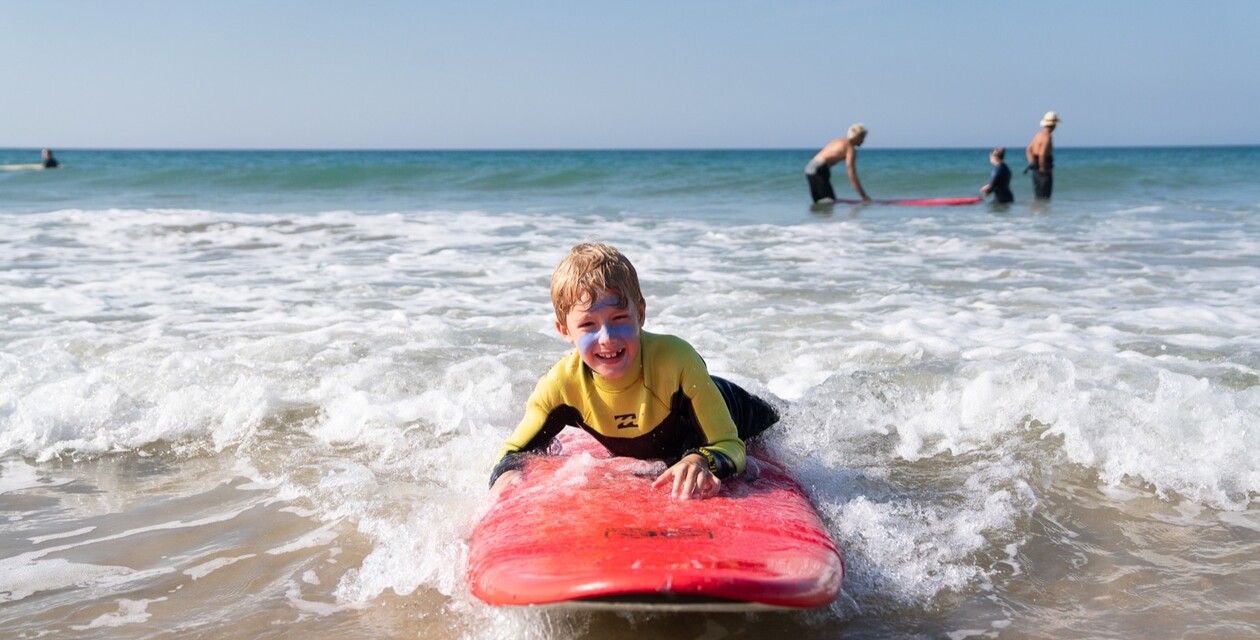
Learning to surf at 40?
Learning to surf from 40 is definitely doable. In our surf courses for adults and families, grandma and grandpa have already stood on the board alongside mom and dad. If you feel fit enough, you can learn to surf at any time. You may not become a pro, but ultimately it's all about having fun in the water. Learning to surf is almost always possible.
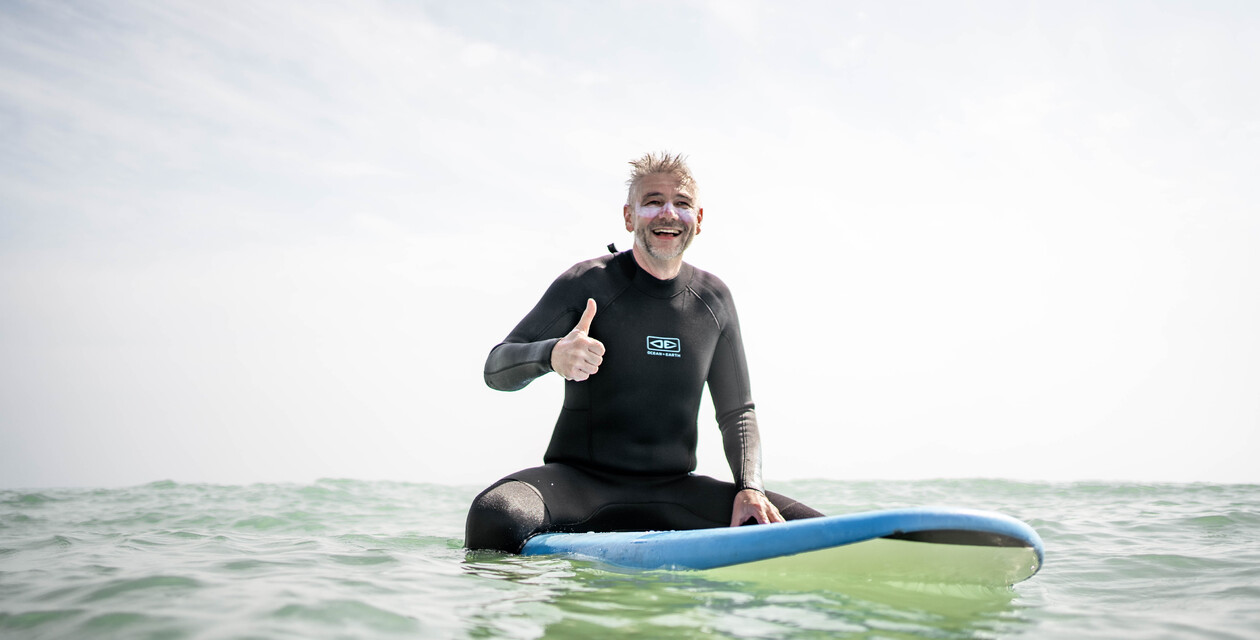
How can you learn to surf?
Learning to surf is an exciting adventure that brings you closer to nature and boosts your fitness and mental strength. However, getting started in this fascinating sport can be challenging. That's why it's best to book a surfing course to learn the basics under professional guidance. This is because the surf instructor will introduce you to surfing step by step and can correct mistakes immediately and practise with you. The safety of a group and the presence of the surf instructor in the water relaxes many beginner surfers. After all, they are usually new to the surfboard and the waves. The surf instructor also knows the surf spot and knows where to go into the water with the surfing students. Remember to carry out a surf spot check before you go into the water on your own.
How you can learn to surf
1. Understanding the basics
Before you get into the water, it's important to understand some basic surfing concepts. These include:
Wave science: Learn how waves form, move and break. This will help you recognize the best waves for your surfing level.
Surfing equipment: Understand the different types of surfboards and which one is best for beginners. A larger, more stable board provides more buoyancy and makes it easier to stand up.
Safety rules: Surfing can be dangerous if you don't follow the basic safety rules. Learn how to behave safely in the water and be considerate of other surfers.
2. Benefits of a surf course
A surf course is the most effective way to learn to surf quickly and safely. Professional surf instructors can teach you the right technique, correct common mistakes and motivate you. Here are some of the benefits of a surf course:
Structured learning methods: A surf course offers a structured approach that includes lessons that build on each other to systematically improve your skills.
Individual guidance: Surf instructors can recognize your individual strengths and weaknesses and give you specific tips to improve your technique.
Safety aspects: A surf course ensures that you know and observe the necessary safety precautions, which is particularly important for beginners.
Ideal for learning to surf: the A-Frame surf camp
3. The A-Frame surf camp in El Palmar
The A-Frame surf camp in El Palmar is an outstanding place to learn to surf. Here are some reasons why you should book your surf course at A-Frame Surfcamp:
Experienced surf instructors: The surf instructors at A-Frame Surfcamp are highly qualified and have years of experience teaching beginners. They offer patient and competent guidance to give you the best possible learning experience.
Optimal conditions: El Palmar is known for its consistent, beginner-friendly waves. The wide sandy beach and beach break make learning safe and enjoyable.
Individual support: The A-Frame surf camp attaches great importance to personal support. In small groups, you will receive individual attention to maximize your progress.
Comprehensive programme: In addition to surf lessons, we also offer theory lessons, video analysis and fitness exercises at the camp to improve your skills holistically.
Community and atmosphere: There is a friendly and supportive community at the surf camp. Here you can meet like-minded people who share your passion for surfing and make new friends.
Further tips
4. practical tips for your surf course
To get the most out of your surf course at A-Frame Surfcamp, follow these tips:
Stay patient: Learning to surf takes time and patience. Don't be discouraged if you have difficulties at first. Every step forward, no matter how small, is a step in the right direction.
Be physically prepared: Good physical fitness will help you make faster progress. Exercises to strengthen your core muscles and improve your stamina are particularly helpful.
Watch your diet: A balanced diet will ensure that you have the energy you need to keep going for long surf sessions.
Use the community: Exchange ideas with other participants, learn from their experiences and support each other.
Conclusion
Learning to surf can be one of the most enriching experiences of your life. By booking a surf course at the A-Frame surf camp in El Palmar, you will benefit from optimal conditions, experienced instructors and a supportive community. Whether you just want to learn the basics or take your skills to the next level, the A-Frame surf camp offers you everything you need for a successful start to surfing. Pack your bags, head to El Palmar and experience the joy and freedom of surfing!
Learn to surf book
If you're looking for a book to help you learn to surf, our blog post about the best surf books will give you a good overview. However, a good tip is always the book "Wave Culture - Fascination Surfing: The surfers' handbook". In this book you will find everything there is to know about surfing:
Book tip: Wave Culture
In this book you will find everything there is to know about surfing:
Surfing history
Surfing courses
Wind & wave theory
Material science
Competitions
Conclusion Learn to surf
Learning to surf is an exciting and rewarding adventure that not only teaches you a new sporting skill, but can also enrich your life. It takes patience, dedication and a positive attitude to master the challenges of the waves. With the right basics, professional instruction and continuous practice, you can make rapid progress and discover the joy of surfing.
Choosing the right place and the best time is crucial to your success. Places like El Palmar offer ideal conditions for beginners, with consistent, beginner-friendly waves and a supportive community. A surf course at A-Frame Surf Camp in El Palmar can help you learn the necessary techniques, avoid mistakes and ensure your safety in the water.
Whether you're starting out on your own or learning in a surf course, remember that any progress, no matter how small, is a step in the right direction. Enjoy the learning process, be patient with yourself and have fun riding the waves. Learning to surf is not only a sporting challenge, but also an opportunity to experience nature and discover a new passion. Pack your surfboard, hit the road and experience the freedom and adventure of surfing!
